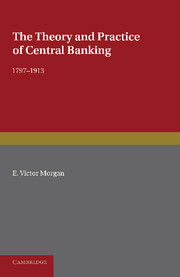Book contents
- Frontmatter
- Contents
- Tables
- Editorial Preface
- Author's Preface
- Chapter I Banks and Banking in the Early Nineteenth Century
- Chapter II The Bank Restriction Period, 1797–1821
- Chapter III Monetary Theory of the Bank Restriction Period
- Chapter IV The First Years of Resumption, the Crisis of 1825, and the Bank Charter Act, 1833
- Chapter V The Horsley Palmer Experiment, and the Bank Charter Act, 1844
- Chapter VI The Currency and Banking Controversy
- Chapter VII The Trial of the Bank Charter Act, 1844-58
- Chapter VIII The Great Boom, 1858-73
- Chapter IX The Great Depression, 1873-96
- Chapter X The Last Years of the Gold Standard, 1897–1913
- Chapter XI Monetary Theory of the Second Half of the Nineteenth Century
- Appendix Changes in Bank rate, 1876-1913, with the Amount of the Reserve of the Banking Department and the “Proportion” on the preceding Wednesday
- Index
Chapter IX - The Great Depression, 1873-96
Published online by Cambridge University Press: 05 June 2016
- Frontmatter
- Contents
- Tables
- Editorial Preface
- Author's Preface
- Chapter I Banks and Banking in the Early Nineteenth Century
- Chapter II The Bank Restriction Period, 1797–1821
- Chapter III Monetary Theory of the Bank Restriction Period
- Chapter IV The First Years of Resumption, the Crisis of 1825, and the Bank Charter Act, 1833
- Chapter V The Horsley Palmer Experiment, and the Bank Charter Act, 1844
- Chapter VI The Currency and Banking Controversy
- Chapter VII The Trial of the Bank Charter Act, 1844-58
- Chapter VIII The Great Boom, 1858-73
- Chapter IX The Great Depression, 1873-96
- Chapter X The Last Years of the Gold Standard, 1897–1913
- Chapter XI Monetary Theory of the Second Half of the Nineteenth Century
- Appendix Changes in Bank rate, 1876-1913, with the Amount of the Reserve of the Banking Department and the “Proportion” on the preceding Wednesday
- Index
Summary
GENERAL CHARACTERISTICS
The period from 1850 to 1873 had been one in which cyclical fluctuations had been superimposed on a marked upward trend in prices. Wages had been rising, unemployment low, and international trade rapidly expanding. The stock of monetary gold was rapidly increasing, yet in spite of this interest rates were generally high. Between 1873 and 1896 all these features were reversed. The various price indices all showed a markedly downward trend, the drop over the whole period being about 40%, or rather more than double the normal cyclical fluctuation of the nineteenth century. It was not until the 1890's that Mr G. H. Wood's wage index rose above the 1874 level, and the rise over the whole period was only 5 %, compared with over 40% between 1858 and 1873. In spite of the great increase in food imports the value of our international trade rose by only a moderate amount—the highest import figure recorded is only 16% and the highest export figure only 10% above those of 1873; the volume of trade, however, increased by more than this, owing to the fall in prices. The Trade Unions unemployment figure shows an average of 5.3%, compared with just under 4.7% for 1856–73. From 1874 to 1879 there was a virtual cessation of foreign investment, and our favourable balance of payments shrank to nothing; there was a recovery to a very high level in the late 1880's, but a fall again in the 1890's.
The world production of gold showed a slight decline, but one which was very small in relation to total stocks. Much more important was the increased demand for gold, as a result of the resumption of cash payments by the Bank of France, and the adoption of a gold standard by Germany, America and a number of smaller countries. Net imports of gold into this country were £74.5 mn. between 1858 and July 1871, but between then and the end of 1888 they were no more than 4.7 mn. A more detailed analysis of movements between 1871 and 1886 will be found in Table XVII.
- Type
- Chapter
- Information
- The Theory and Practice of Central Banking, 1797–1913 , pp. 187 - 208Publisher: Cambridge University PressPrint publication year: 2013



